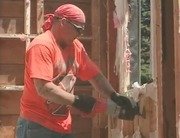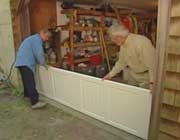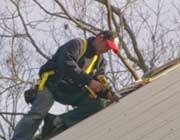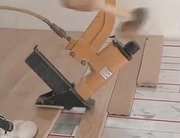Hi, I'm Bob Villa.
Welcome to the show here in Norwell, Massachusetts where we're adding on to an existing house to create an in-law suite and we are using ICF's, insulated concrete forms, for the bulk of the building.
We're going to give you a recap of how all of that has come together today.
We're also installing some steel garage doors.
We have two existing garage bays where we're replacing the old ones.
We have two new bays, where we'll show you how they are installed.
Also, lots of framing.
Stick around.
It's good to have you with us.
Okay, we're gonna get started today replacing some garage doors.
And, although how Howard Brickman our homeowner is primarily working on creating this in law suite.
We're obviously doing some improvements to his twenty-five-year-old house which he built himself.
Howard, when you built, excuse me, you're taking things apart there, but when you built this house you really built it with a budget in mind, right?
Yes, it was fresh moved from the south to the Boston area 25 years ago and, we had the budget from Memphis to Boston, so we were watching our pennies when we built the house.
Did you ever calculate what it cost per square foot to build it back then?
It was right around 50 dollar s a square foot.
You couldn't do that today?
No.
No.
So one of the improvement's that you are making is to kind of upgrade your garage doors.
You got two garage doors from the original house and you will have two new entrances on the new side.
Correct.
Yeah.
What kind of door is this?
Well it is relatively inexpensive door.
It's a fiberboard and a a wooden frame.
Very inexpensive door even 25 years ago.
Not only is it flimsy, but it has absolutely no insulating value.
No.
Okay , and go ahead, let's get these old panels taken apart here.
And Bob Rany is on the inside, who's helping us from PJ overhead doors, and what do you have to take off down there?
Well, we took off the, we undid hardware so we can actually lift a section out right now, and then we proceed from there.
Did you take all three of them out?
Yes we can.
Now you can't reuse the hardware?
No we don't.
It's worn.
Some of it is rusty.
The track is different nowadays.
We're going with different track we're going low head
So, by large the best thing to do with that is just throw it away.
OK.
And that's what we're going to do.
Throw it away.
It's as flimsy as the door was, OK.
Yes.
Now, before I take this last one out, we're going to get rid of another section here.
Alright, I will swing it in and slide it out.
There you go.
Now this one here.
Swing it, you can just swing it to me and we can pull it right out.
So what are some of the features of the door?
Well, it is a steel two sided door.
It has 24 gauge exterior, twenty seven gauge interior.
Is there any insulation?
Yes, it has two inches of polyurethane insulation in it.
Gives it an R value of thirteen.
Now that's probably like thirteen Rs more than what you had there.
Oh, yeah.
Maybe fourteen.
Yep, there was not much there.
And the finish on the door is interesting, it's kind of an embossed wood grain on this side.
Is this the side that goes to the weather?
This is actually the back of the door, Bob.
This exposed face, is this embossed panel, that has a carriage door design to it.
That's very nice.
So it's very handsome.
Yeah, it looks like a paneled...
And it has a wood grain embossed on it as well.
Right.
So it has a very similar appearance to a wood grain door, with all the performance characteristics of a back refinished metal.
Excellent, now Bob, what's the first step in installing something.
It's three panels, right?
Or is it four?
It's three panels.
Three panels.
These are the pieces that go with the track.
Alright, we'll just watch as we put them all together.
Okay, so we've got the hardware pieces in and the roller pieces in.
And this came through with the door, right?
Yes.
This is probably one of the more important parts of the door.
Yeah, that rubber gasket will actually keep the air and water from infiltrating into the garage.
It's very important to seal this space in.
Alright Bob, we have to flip it, don't we?
Yes.
So, before you fiddle with the track or anything, you put your first piece in.
And now you have to go get the track and start assembling it, right?
Yes, yes, we do.
Okay.






